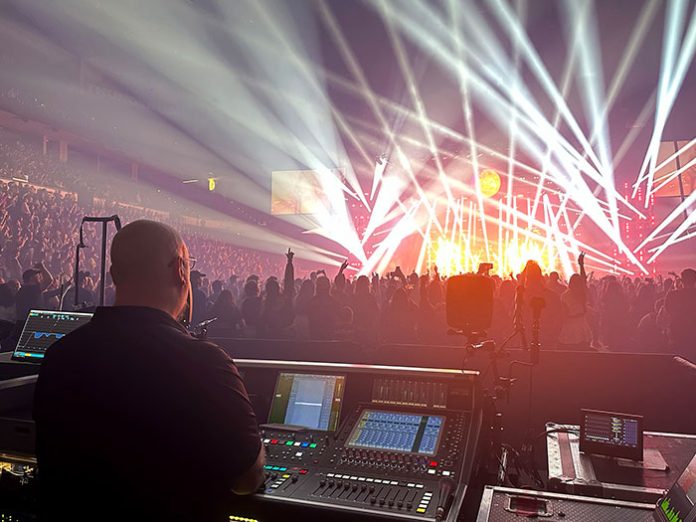“I don’t know that there’s another desk that we could really do it all with,” began Chad Olech, front-of-house mix engineer for Fall Out Boy, talking about managing the band’s comms infrastructure that sees three separate talkback lines coming into his DiGiCo Quantum5 console.
Rob Smuder is one of those comms sources, as he mixes the band’s monitors from a DiGiCo Quantum7 console, along with the stage manager and backline crew lines. “The main reason that I use the Q7 out here, honestly, is the matrixes,” commented Smuder. “We have a ton of talkback mics that are routed all over the place; each backline person has two talkbacks, one to talk to the crew and one to talk to their band member; and all the radios go through the console. Meanwhile, the front-of-house has three talkbacks to go to various places. There’s a pretty robust network of us talking to each other during the show. It can get pretty chatty! But the Quantum7 matrix helps me route all of that stuff so much more reliably and effectively, and that lets me focus on the stage mixes.”
Olech had used a DiGiCo SD5 desk for Fall Out Boy’s live sound since 2014, when he spent three days going over six different console options at the Lititz, Pennsylvania headquarters of Clair Global, which supplies the band’s Cohesion PA system.
When the current tour was being planned last year, he chose to bump up to the updated Quantum5, along with a pair of SD-Racks with 32-bit mic pre’s that would connect across an Optocore network loop with the Quantum7 console at monitors. “The sound, the workflow—everything just worked perfectly for me on the Q5 for what I needed,” he noted.
Those needs include the ability to interface with the two 18-space racks of analog outboard gear that he relies on to help reproduce Fall Out Boy’s sound onstage. Those include a Sonic Farm Creamliner and API preamps and a Rupert Neve Designs 5045 Primary Source Enhancer. “Basically, I just transferred my file over and took maybe three minutes to pop it all together,” he recalled. “It was such an easy transition.” He added that he’s been experimenting with adding on some of the console’s Spice Rack processing options, such as Mustard for channel-strip processing.
But then there’s the management of that sprawling comms network. “It’s gotten a little out of control over the years,” laughed Olech. “It’s one of those things where you add this and then you add that, so now you got to add this, and so on. And I think that now we’re up to over 16 talkback channels, plus I have three talkbacks to the stage on my console. For a four-piece band! I don’t know that we could do it with any other desk than a DiGiCo.”






